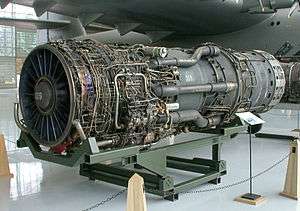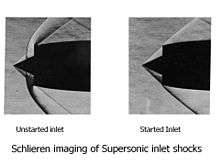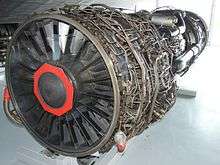Pratt & Whitney J58
| J58 | |
|---|---|
 | |
| J58 engine on display at the Evergreen Aviation & Space Museum | |
| Type | Turbojet |
| Manufacturer | Pratt & Whitney |
| First run | 1958 |
| Major applications | Lockheed A-12 Lockheed SR-71 |
|
| |
The Pratt & Whitney J58 (company designation JT11D-20) was a jet engine that powered the Lockheed A-12, and subsequently the YF-12 and the SR-71 aircraft. The J58 was a single-spool turbojet with an afterburner.[1] It had a unique bleed from the compressor to the afterburner which gave increased thrust at high speeds.[2] This feature caused it to be referred to as a turboramjet in some writings. It delivered 25,000 pound-force (110 kN) of thrust dry and 34,000 (150 kN) wet.
Design and development
Origins
The J58 had its origins in the bigger JT9 (J91) engine. It was a 3/4 scale JT9 with a mass flow of 300 lb/s, down from 400 lb/s and known by the company designation JT11.[3] The JT11 was initially proposed for the US Navy, hence its Navy designation J58.[3] It was also promoted for use on various Navy and Air Force aircraft, e.g. Convair F-106, North American F-108, Convair B-58C, Vought XF8U-3 Crusader III, and North American A3J Vigilante, which never materialized.[3]
The J58 was initially developed for the US Navy [4] to power the planned version (using the J58)[5] of the Martin P6M jet flying boat.[6] The P6M started out using Allison J71-A-4 engines and then switched to the Pratt & Whitney J75 as the J58 wasn't ready due to development problems. Upon cancellation of this aircraft, it was selected for the Convair Kingfish and for the Lockheed A-12, YF-12A and SR-71. Other sources link its origin to the USAF's requirement for a powerplant for the WS-110A, the future XB-70 Valkyrie.[7]
Re-design for Mach 3.2

The J58 for the A-12 had to be almost completely redesigned from its original Navy proposal so that it could operate continuously at Mach 3.2. The complete engine had to endure the temperatures of sustained flight at this speed and had to be designed accordingly.
The compressor redesign, as well as addressing the need for high temperature materials such as Waspaloy in the rear stages[8] had to address the aerodynamic shortcomings inherent in any turbomachine compressor when ingesting very hot air (800 °F or 427 °C at Mach 3.2).[9] The route chosen to keep the J58 compressor pumping was to bleed air from the compressor 4th stage through 6 external tubes to the afterburner. In addition a 2-position trailing edge flap was added to the inlet guide vanes.[2] The bleed and adjustable flap position kept the compressor working efficiently despite the high temperature air delivered to it by the intake.
The afterburner received the exhaust from the turbine as well as the bleed air from the compressor. Most of the compressor bleed was required for cooling the afterburner duct and propelling nozzle and the remainder was used, together with the turbine exhaust, to burn the afterburner fuel flow.[2]
The combustor liner and flame holders were sprayed with ceramic thermal barrier coating[10] to allow sustained afterburner operation at temperatures up to 3,200 °F (1760 ℃).[8]
Partial ramjet
Referring to the engine in ramjet terms, although popular in non-specialist writings, is not necessary for a complete understanding and characterization of its behaviour. However, it is sometimes called a turboramjet, or something similar, as an alternative way of describing two features. They are the bleed bypass and the dominant thrust-producing role of the afterburner at cruise. Both these features are very apparent visually, the 6 external bypass tubes, and, on photographs, the yellow-hot afterburner casing during maximum-afterburner testing of the uninstalled engine.
The recover bleed solution extended the capability of the original J58 to M3+ converting the engine into a partial ramjet.[11]
Turboramjet engines have a transition from turbojet mode to ramjet mode as thrust-producing flow is transferred from the high pressure inner part to the low pressure outer part.[12] During the transition the turbojet may have its fuel flow reduced as the ramjet parts take over thrust production. For example, in the Nord Griffon 02 the turbojet RPM was reduced to 90%.[13]
The optimum flight Mach number for transition on the J58 was about Mach 2. At higher speeds opening the bleed would have caused a jump in engine airflow which could have unstarted the intake.[11]
Turboramjet engines may be classified according to the manner of energy transfer to the ramjet parts and whether they have a separate combustor.[12] In the Griffon 02 power plant the turbojet was separate from the ram duct, which had its own combustor, and there was no energy transfer. In the J58 there was energy transfer from the gas generator to the bypass flow (from the compressor) and to the afterburner (from the turbine exhaust).
During transition, fuel to the gas generator was not reduced, as in the Griffon 02 when the external flow was burning, but thrust available from the gas generator automatically decreased as a consequence of operating at a fixed turbine temperature limit and with increasing compressor inlet temperature.[9] The gas generator RPM was kept at 100% to maintain maximum thrust. The transition to partial ramjet operation may be viewed as complete when, at cruise, the exhaust gas from the gas generator had no residual energy left for thrust production and all the engine thrust came from the afterburner.[14] The afterburner may be viewed as a ramjet combustor with energy transfer from the turbine exhaust gas. In this characterization as a partial-ramjet[12] the ram air burned in the combustor was about 8% of the turbine exhaust that was reheated (most of the 20% ram air was used for cooling[2] ). The airflow through the intake was being induced, or pumped, by the gas generator and heated with maximum afterburner,[14] which gave a thrust distribution, at Mach 3+, of 54% inlet, 17.6% engine, 28.4% propelling nozzle.
The engine was part of the complete powerplant which, with intake and propelling nozzle, may be called a partial ramjet.
Contemporary compressor solutions for Mach 3 flight
Alternative solutions to combat the adverse effects of high inlet temperature on the aerodynamic performance of the compressor were rejected by the Pratt & Whitney patentee, Robert Abernethy.[15] One of those solutions was used in a contemporary installation. The GE YJ93/XB-70 used a variable stator compressor to avoid front stage stall and rear stage choking.[16]
Another possible solution, pre-compressor cooling, was used on the MIG-25. Water/methanol was injected from a spray mast in front of the compressor to lower the intake temperature for short durations at maximum speed.[17] Pre-compressor cooling was also proposed for a Mach 3 reconnaissance Phantom[18] and the Mach 3+ F-106 RASCAL project.[19]
Starting
A variety of engine starting operations were available throughout the life of the A-12, F-12 and SR-71 aircraft, including: A twin chamber mono-fuel starter, attached to the engine only for starting, an AG330 starter cart, with two Buick Wildcat V8 internal combustion engines driving a common output, spinning the J58 to 3,200 rpm before the turbojet could self-sustain.
Fuel
The engine's high operating speeds and temperatures required a new jet fuel, JP-7. Its reluctance to be ignited required triethylborane (TEB) to be injected into the engine to ignite it and the afterburner. Above -5 °C, TEB spontaneously ignites in contact with air. Each engine carried a nitrogen-pressurized sealed tank with 600 cm3 (20.7 ounces) of TEB, sufficient for at least 16 starts, restarts, or afterburner lights; this number was one of the limiting factors of SR-71 endurance, as after each air refueling the afterburners had to be reignited.[20] When the pilot moved the throttle from cut-off to idle position, fuel flowed into the engine, and shortly afterwards an approx. 50 cm3 (1.7 ounce) shot of TEB was injected into the combustion chamber, where it spontaneously ignited and lit the fuel with a green flash. In some conditions, however, the TEB flow was obstructed by coking deposits on the injector nozzle, hindering restart attempts. Refilling the TEB tank was a perilous task; the maintenance crew wore silver fire suits.[21] Conversely, the JP-7 fueling was so safe that some aircraft maintenance was permitted during filling. The chemical ignition was chosen instead of a conventional igniter for reliability reasons, and to reduce mechanical complexity. The TEB tank is cooled with fuel flowing around it, and contains a disk that ruptures in case of overpressure, allowing TEB and nitrogen to discharge into the afterburner.
The fuel flowing into the engine is used as a coolant to cool the engine, hydraulic fluid, oil, TEB tank, afterburner nozzle actuator control lines, air conditioning systems, and the parts of the airframe subjected to aerodynamic heating.
Propulsion system design

The propulsion system consisted of the intake, engine, nacelle or secondary airflow and ejector nozzle (propelling nozzle).[14][22] The propulsive thrust distribution between these components changed with flight speed: at Mach 2.2 inlet 13% - engine 73% - ejector 14%; at Mach 3.0+ inlet 54% - engine 17.6% - ejector 28.4%.[14]
Intake

The intake had to supply air to the engine with minimum pressure loss and distortion and at the speed dictated by the engine, namely about Mach 0.4. It had to do this at all flight conditions.
Nacelle airflow and ejector nozzle
The ejector nozzle performed the reverse function of the inlet accelerating the turbine exhaust from about Mach 0.4 back up to Mach 3.[23] Mach 3 exhaust velocity is higher than Mach 3 flight velocity due to the much higher temperature in the exhaust. The nacelle airflow from the intake controlled the expansion of the hot engine exhaust in the ejector nozzle.[24] This air flowed around the engine and served also to cool the hot external parts of the engine and to purge any combustible mixtures in the event of a fuel or oil leak in the nacelle.
Applications
Specification of JT11D-20

General characteristics
- Type: afterburning turbojet with compressor bleed bypass
- Length: 17 ft 10 in (5.44 m) (an additional 6 in (15 cm) at max. temp.)
- Diameter: 4 ft 9 in (1.45 m)
- Dry weight: approx. 6,000 lb (2,700 kg)
Components
- Compressor: 9-stage, axial flow, single spool
- Combustors: 8 can, annular
- Turbine: two-stage axial flow
- Fuel type: JP-7 or JP-4 or JP-5 for emergency refuelling from any tanker (Mach 1.5 limit)[25]
Performance
- Maximum thrust: 34,000 pounds-force (150 kN) wet, 25,000 pounds-force (110 kN) dry
- Overall pressure ratio: 7.5 at take off[26]
- Specific fuel consumption: 1.9[27]
- Thrust-to-weight ratio: approx. 6
- air flow: 300 lb/s, (136 kg/s)at take off[26]
See also
- Comparable engines
- General Electric GE4
- General Electric YJ93
- Rolls-Royce/Snecma Olympus 593
- Kuznetsov NK-321
- Tumansky R-15
- Reaction Engines SABRE
- Related lists
References
- ↑ Kloesel, Kurt J.; Ratnayake, Nalin A.; Clark, Casie M. "A Technology Pathway for Airbreathing, Combined-Cycle, Horizontal Space Launch Through SR-71 Based Trajectory Modeling" (PDF). Dryden Flight Research Center. NASA. Retrieved 7 September 2011.
- 1 2 3 4 U.S. Patent 3,344,606, "Recover Bleed Air Turbojet," Robert B. Abernethy
- 1 2 3 "The Engines of Pratt & Whitney: A Technical History" Jack Connors, ISBN 978-1-60086-711-8
- ↑ "Factsheets: Pratt & Whitney J58 TurboJet". National Museum of the Air Force.
- ↑ "A Look at the Pratt & Whitney J-58JT11D-20". Atomic Toasters. 2012.
- ↑ "Martin P6M Seamaster". The Aviation History On-Line Museum. Created April 12, 1997. Updated November 2, 2013.
- ↑ Goodall, James and Jay Miller. "Lockheed's SR-71 'Blackbird' Family A-12, F-12, M-21, D-21, SR-71". Hinckley, England: AeroFax-Midland Publishing, 2002. ISBN 1-85780-138-5
- 1 2 http://www.enginehistory.org/Convention/2013/SR-71PropulsionSystem-2013.pdf
- 1 2 "Jet Propulsion for Aerospace Applications" Second Edition, Walter J. Hesse Nicholas V.S. Mumford Pitman Publishing Corporation 1964 Fig 14.7 "Compressor performance map showing effect of flight Mach number on operating points"
- ↑ "History of Thermal barrier Coatings for Gas Turbine Engines emphasising NASA's role from 1942 to 1990" Robert A. Miller, NASA TM 2009-215459
- 1 2 "More Never Told Tales of Pratt & Whitney" Dr. Bob Abernethy, Presented to the Roadrunners and the J58 Reunion, March 26, 2004
- 1 2 3 "Turboramjet Engines - Types and Performances"" Dr.M.M.Tskhovrebov, CIAM, Moscow, AGARD-LS-194, December 1993
- ↑ "Past Flight Experience And Recent Developments In Combinations Of Ramjet And Turbojet Engines" A. Gozlan, Nord Aviation, France, AGARDograph103 Aerodynamics of Powerplant Installations, Part 1, October 1965
- 1 2 3 4 "F-12 Series Aircraft Propulsion System Performance and Development". David H Campbell J. Aircraft Vol II NO 11 November 1974
- ↑ U.S. Patent 3,344,606, "Recover Bleed Air Turbojet", Robert B. Abernethy
- ↑ "Jet Propulsion for Aerospace Applications- second edition" Walter J. Hesse, Nicholas V.S. Mumford, Jr. Pitman Publishing corporation p377
- ↑ de:Mikojan-Gurewitsch MiG-25
- ↑ http://aviationtrivia.blogspot.com.au/2012/07/the-mach-3-phantom.html "Tails Through Time" J P Santiago Wednesday,July 18, 2012 "The Mach 3 Phantom"
- ↑ http://www.f-106deltadart.com/rascal_project.htm
- ↑ http://www.netwrx1.com/skunk-works/v05.n717
- ↑ http://yarchive.net/air/sr71.html
- ↑ http://www.liveleak.com/view?i=e52_1412578776&comments=1
- ↑ http://www.enginehistory.org/Convention/2005/Presentations/LawPete/SR-71Propulsion2.pdf
- ↑ http://arc.uta.edu/publications/cp_files/AIAA%202003-0185.pdf
- ↑ "SR-71 Revealed"Richard H.Graham,Col USAF(Retd) ISBN 978-0-7603-0122-7 p46
- 1 2 "The Engine of Pratt & Whitney:A Technical History"Jack Connors ISBN 9781-60086-711-8 p325 J58 compressor map showing the take-off operating point
- ↑ http://www.jet-engine.net/miltfspec.html
External links
| Wikimedia Commons has media related to Pratt & Whitney J58. |
- Pratt & Whitney J58
- EngineHistory.org P&W J58 images
- SR-71 Online - J58 Engine Photos
- U. S. Patent 3,344,606, "Recover Bleed Air Turbojet," Robert B. Abernethy
- U. S. Patent 3,477,455, "Supersonic Inlet for Jet Engines," David H. Campbell.
- The Mighty J58 - The SR-71's Secret Powerhouse on YouTube